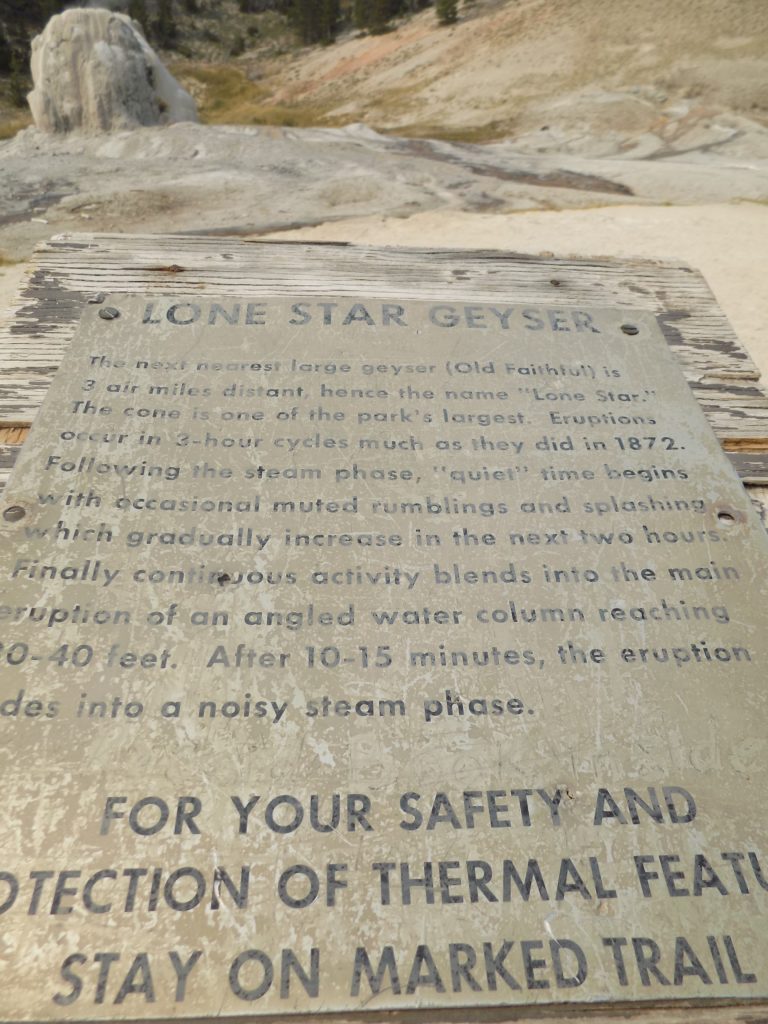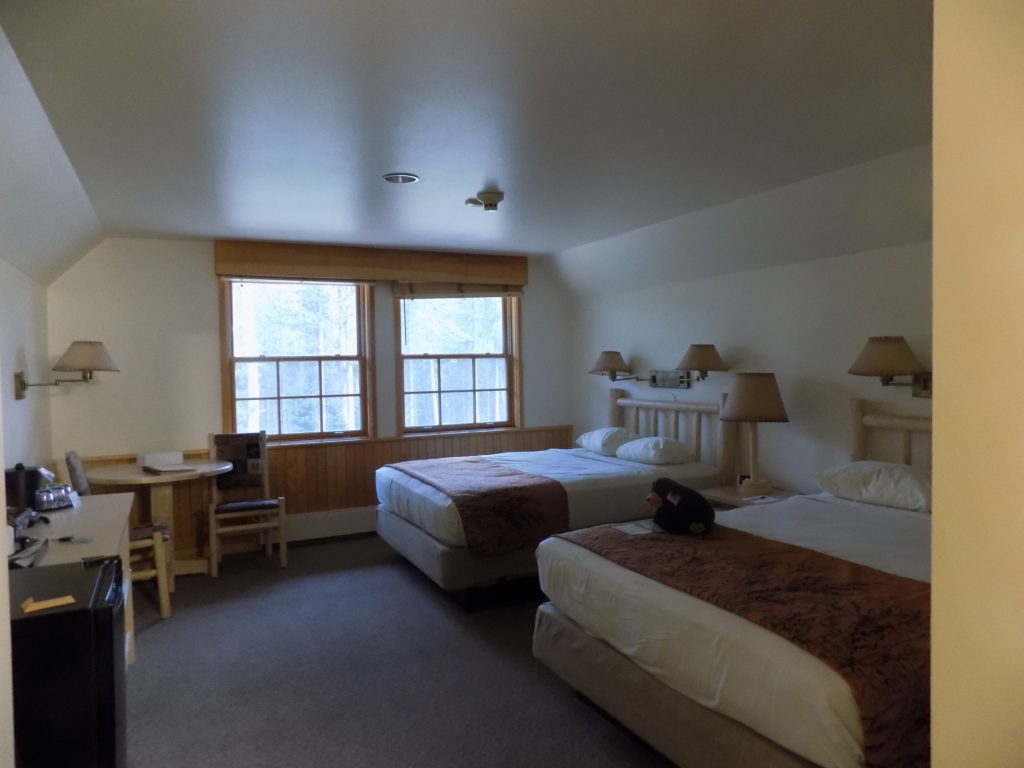Lone Star – No Show
I’d started up the trail at a moderate pace and after a few minutes came to a dividing point. It seemed that the main trail went to the left but I recalled, and spoke aloud, one of the famous expressions attributed to Yogi Berra, “When you come to a fork in the road, take it,” so I followed the branch to the right which led me closer to the river where I met Craig and Linda from Minnesota.
Craig was casting his fishing line into the river as Linda and I began chatting. They too, were planning to walk up the trail to Lone Star and, happy for the company, we began to walk together. Craig must have read the lines in the NPS description of the Firehole River as one of the favored fly-fishing spots in the park so we’d stop at intervals of a few hundred yards while he went about fruitlessly casting his line into the river.
As I write this two months after the events I can’t recall the details of our conversation but it was engaging enough that I was content to amble along with them at a leisurely pace. It turned out to be a trade. By the time we reached the geyser, this is what we encountered.
We learned from some fellow hikers that we’d missed the eruption by about 15 minutes and, as the sign pointed out,
 this geyser erupts in three hour cycles. None of us had any interest in waiting hours so we watched the vent gently steam for a few minutes before turning back down the trail and returning to our cars. Craig, apparently having given up on his ambition to catch a Yellowstone trout, didn’t stop to fish.
this geyser erupts in three hour cycles. None of us had any interest in waiting hours so we watched the vent gently steam for a few minutes before turning back down the trail and returning to our cars. Craig, apparently having given up on his ambition to catch a Yellowstone trout, didn’t stop to fish.
We’ll always have Old Faithful
If no visit to Yellowstone can be considered complete without seeing geysers then the de rigueur geyser to see is, of course, Old Faithful. Here’s how Wikipedia says it got its name:
On the afternoon of September 18, 1870, the members of the Washburn-Langford-Doane Expedition traveled down the Firehole River from the Kepler Cascades and entered the Upper Geyser Basin. The first geyser that they saw was Old Faithful. Nathaniel P. Langford wrote in his 1871 Scribner’s account of the expedition:
“It spouted at regular intervals nine times during our stay, the columns of boiling water being thrown from ninety to one hundred and twenty-five feet at each discharge, which lasted from fifteen to twenty minutes. We gave it the name of “Old Faithful.”
(I have to admit that the adjective in the name has long puzzled me. Unless they planned to give a similar name to another geyser, why wouldn’t they just name it Faithful? “This one here is just as faithful but we found that other one first so now we call it Old Faithful.”)
Two incidents that happened to me at Old Faithful are an object lesson in why, even when circumstances in your travel adventures appear to have gone sideways, if you remain open to them new experiences beckon that you otherwise might missed. The first was a mere coincidence and could have happened regardless of the Lone Star Geyser disappointment. The second (which quite probably led to a third) would likely have not happened.
I’ll start with the coincidence. As I noted above, a visit to Old Faithful is something of a must for any visitor – especially first time visitors – to Yellowstone. And one can analogize the parking lot around the Old Faithful Inn and Visitor Center and the viewing benches and platform around it to the geyser itself.
While the eruptions are reasonably predictable, Old Faithful has what’s termed a bimodal distribution. In predicting the time of an upcoming eruption, scientists must first measure the duration of the eruption that immediately precedes the next. A lengthy eruption can mean a wait of up to two hours until the next one while a short burst usually means the next gusher will spew forth in 35 minutes or so. Depending on the source you read, the reported average time between eruptions is between 74 and 90 minutes.
The Old Faithful Visitor Center and most buildings in the Old Faithful area post predicted eruption times and these are usually accurate within plus or minus 10 minutes. These prediction times are also available on various websites. If you miss those, you can also use one of these geyser gazer indicators. First, within 20 to 30 minutes of a scheduled eruption, the parking lots at Old Faithful begin to fill. Then, within seven to 10 minutes of the predicted eruption time the crowd in the viewing area begins to also reach critical mass. Before and during the eruption, it looks something like this photo from the Idaho State Journal.
Within two or three minutes after the eruption, both the viewing platform and the parking lot empty spewing forth the hordes of visitors who have seen what they came to see.
When I arrived at Old Faithful I had to search the parking lot for a space – my first indication that an eruption was nigh. However, I had to first stop in the Visitor Center because, while my own internal liquid hadn’t superheated, it was demanding its own eruption. With that business taken care of, I had just four minutes until Old Faithful’s predicted gusher. Now, this ideal timing might have happened had Craig, Linda and I walked to Lone Star without stopping but, then again, it might not have. I shot this video but much of the eruption fades against the ash gray sky. As it turned out, it was actually after the eruption that the fun really began.
Like nearly everyone else, having seen the geyser do what geysers do, I returned to my car and joined the slow moving line of traffic squeezing out of the parking lot. About 150 yards before I reached the turnoff to the main road I noticed three young people – two girls and a guy – walking slowly through the traffic holding a makeshift sign on which they had scrawled “Canyon Village.” Since that was my destination, I pulled over as far as I could and invited them to hop in. They all crowded into the back seat.
Paulo was from the Dominican Republic and the two women who called themselves Huiwen and Peishan were Taiwanese. They were in the park for the summer and had met working in the General Store at Canyon Village. All in their twenties, they’d come as part of a program that hires foreign nationals to work in the park for what, to me, sounded like long hours and low wages. They were making the best of it, though, by exploring the park on their rare off days. Paulo was also planning a trip to California when his stint was done on 15 September. The two women were returning directly to Taiwan where one would start working and the other would enter graduate school.
Though they’d been in the park most of the summer, they didn’t know the road system very well so I followed the route I knew and headed back east toward Yellowstone Lake. (At 55 miles, this route is about a dozen miles longer than the more direct western segment of the loop but I had no internet availability so I chose the known, safer option.) They actually hadn’t seen that part of the park and it was quite fun to listen to them react to the new sights. Of course, ever the pedant, I told them a little about the park’s geology and explained the continental divide.
I thought they might enjoy seeing the Fishing Bridge across the Yellowstone River so I made the very brief detour onto East Entrance Road before turning back and heading north on the Grand Loop Road. About five miles north of the junction, we encountered
 this herd of bison grazing by the road. Although none had wandered off the grass, we nevertheless found ourselves in the midst of one of Yellowstone’s famous “buffalo jams.” Similar wildlife jams occur with bears and less frequently, wolves. (In August of this year, the NPS released a study that claims that every wildlife jam results in a 30 to 120 minute traffic backup and that, at the peak visitation times, visitors spend 60 to 80 percent of their time in the park closely behind other vehicles. If the problem continues, there’s already been speculation that Yellowstone will institute some sort of shuttle system akin to the one in the much smaller Zion National Park.)
this herd of bison grazing by the road. Although none had wandered off the grass, we nevertheless found ourselves in the midst of one of Yellowstone’s famous “buffalo jams.” Similar wildlife jams occur with bears and less frequently, wolves. (In August of this year, the NPS released a study that claims that every wildlife jam results in a 30 to 120 minute traffic backup and that, at the peak visitation times, visitors spend 60 to 80 percent of their time in the park closely behind other vehicles. If the problem continues, there’s already been speculation that Yellowstone will institute some sort of shuttle system akin to the one in the much smaller Zion National Park.)
I dropped the three grateful youngsters at the store in Canyon Village and looped around to check into my hotel with its basic (though comfortable) room
and its pleasant, if far from inspiring, view.
Tomorrow, I’ll have another full day to explore the park and, in that entry, will give you a more detailed geology lesson than I did my hitchhiking trio.



